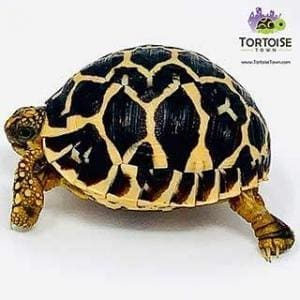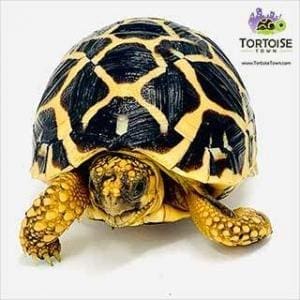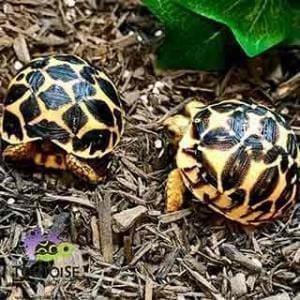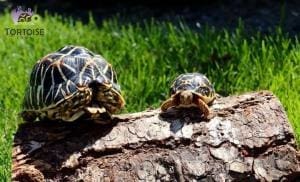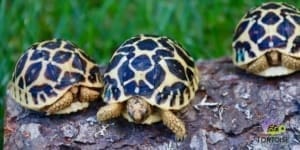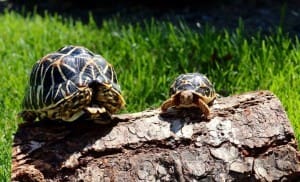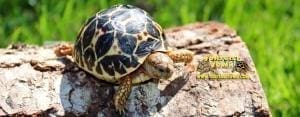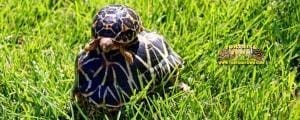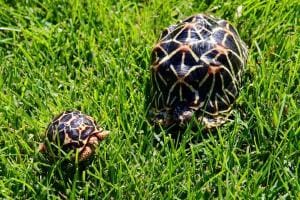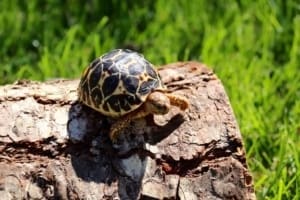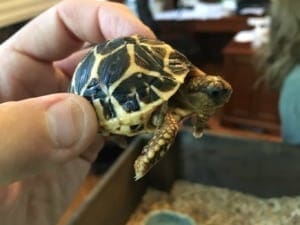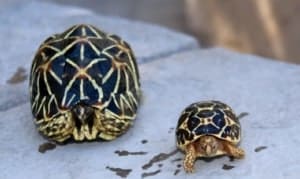Indian Star Tortoise Care Sheet
Before purchasing a new baby Indian star tortoise, or an adult Indian star tortoise for sale, it is imperative that you locate reputable Indian star tortoise breeders. Indian Star Tortoise breeders should be chosen by breeders that only sell captive bred baby Indian star tortoises for sale.
The Indian star tortoise is one of the most beautifully decorated tortoises and is relatively uncommon as a pet. These tortoises are from the “dry-zones” of India and Sri Lanka. Because of this being their natural habitat, this is the environment that we try to replicate when keeping them. In contrast, Indian Stars require different care than the more common Mediterranean tortoises. As hatchlings, they have a shell just a few cm (just over an inch) long. In contrast, as adults, females can be 25 cm (10 inches) long.
Indian Star tortoise Size
Interestingly, male Indian Star Tortoises for sale are usually under 20 cm (8 inches) long. Because most of the growth happens in the first 10 years. Most noteworthy, Indian Star tortoises normally live for about 30-50 years. In comparison but the current record is 55 years in their natural habitat. Lastly, in common tortoise terminology, they are tortoises, not turtles, as they do not live in water.
Star tortoise babies are some of the cutest baby tortoises for sale in the world!
Firstly, as baby Indian star tortoises, these youngsters, they have beautiful yellow butterfly-shaped markings on a rich, black background. Secondly, as they grow, the yellow markings extend into narrow star rays. Rays grow pointing in all directions from the center of each scute. In comparison, Indian Star Tortoises for sale are a tad shyer shy than the common Mediterranean tortoises. Secondly, Indian star tortoise for sale does not demand so much attention. In contrast, Indian stars are terrestrial, living on the ground and just need access to water where they can soak, and drink. They can be quite sedentary, with a significantly slower walking speed.
Indian Star Tortoises can live comfortably in smaller spaces than equally sized Mediterranean tortoises. Because the Indian Start tortoise has with lower requirements for attention and exercise. They are still, however, quite charming, and are intelligent enough to bond with their owners.
Star Tortoise humidity
These animals are from humid environments, so although in some cases it is possible to use a tortoise table enclosure, wooden vivariums with sliding glass doors are best, as the humidity needs to be managed in the enclosure. The ventilation in most vivariums is not adequate, and extra vents will need to be added (for example, add 10 round 70 mm – just under 3 inches – soffit vents). Alternatively, the glass doors can be wedged open a few cms (an inch). All wooden joints should be sealed with aquarium silicone to avoid water damage.
If using a tortoise table enclosure, the walls need to be taller than the length of the tortoise’s shell and must be slippery so that the tortoise cannot climb them. Pine enclosures must be coated in non-toxic paint or varnish, to prevent the pine from releasing toxins when it is heated.
Baby Indian Star Tortoise Care – Habitat
The tortoise should not be able to see out through any glass in front of them. If they can see out, it makes them want to get out, which can be stressful. They cannot see glass, and may be injured by trying to climb through it. If needed, a visual barrier can be painted on the outside of any glass with non-toxic (eg. water-based acrylic) paint. This barrier should be taller than the length of the tortoise’s shell. All-glass enclosures are difficult to heat and light correctly for a tortoise, and would still need to be modified to add visual barriers. They should not be used for tortoises.
An enclosure of 3 feet long and 15 inches wide can serve one or two tortoises for their first 2 to 3 years. Alternatively, an enclosure 4 feet long and 2 feet wide can serve them for their first 4 to 5 years. A few feet larger will be perfect once fully mature as their adult enclosure for the remainder of their lives. The height is irrelevant as long as it can be heated and lit correctly, but it is normally best to use a terrestrial vivarium. Use something that is about 18 inches high.
Remember, tortoises can escape if they are able to climb out. Escaped tortoises can live for several weeks hiding in a dormant state in a house but normally can be found before they come to harm. If they find their way outdoors, they may never be found and will die in winter conditions.
Baby Indian Star Tortoise – substrate
The enclosure needs to have an unscented substrate (bedding) on the bottom that is designed for retaining humidity. Because of this, it can also offer the tortoise something to grip onto. Also, this can allow them to dig shallow nests and is safe if accidentally eaten. If the tortoise lives on a slippery surface, their muscles and joints will not form correctly. Because of. this, they will be unable to get up if they fall on their backs. The substrate should be as deep as the length of the tortoise’s legs, or a little deeper.
Fine grade bark chips can work well, but compacted coconut fiber is another option. Some owners like to use more than one type of substrate (such as tortoise pellets, made from straw). Variations of the substrate can be placed at different locations in the enclosure. Keep in mind that the humidity-retaining substrate should be used under or near the basking lamp. Keep in mind that Mazuri tortoise food, and other tortoise pellets degrade rapidly when exposed to moisture. Lastly, you can use cypress mulch, however, if too small, can contain sharp pieces and may cause injuries.
Choosing the right substrate for your baby Star tortoise for sale is key!
Aspen, hemp, beech, and other wood chips are not suitable. Sand is especially dangerous, as tortoises drag their food onto the floor to eat it, and are prone to eating the substrate. Because of this, sand can cause severe internal blockages that may result in death. Although these tortoises can sometimes be found near sandy areas. In nature, they do not naturally eat sand. Indian Star tortoises feed on the plants they eat grow above the sand and dirt areas. Lastly, sand also has a severe dehydrating effect. Soil is a little better, but still causes problems when eaten, doesn’t absorb odors.
Indian Star tortoise heating
During the daytime, a basking lamp heats one end of the enclosure to over (86 to 95°F), leaving the other end at about room temperature. This creates a heat gradient with lots of choices of temperature, allowing the tortoise to warm up when it needs to, and cool down when it needs to. The tortoise chooses the temperature it wants.
The bulb should be mounted so that it hangs above the tortoise, about halfway between the front and back of the enclosure. Alternatively, keep it a similar distance from the end wall. Night time temperatures in nature are higher than a typical home, some nighttime heat is required. The intention is to have a warm part of the enclosure with a temperature of at least 72°F at night.
Indian Star Tortoise for sale – Indian Star tortoise heating
This can be provided by a low power heat mat stuck to the ceiling or wall (not the floor) at the warm end of the enclosure. Ideally, this is controlled with a mat thermostat so that it does not change throughout the year. Heat in nature comes from the sun, and tortoises are not adapted to using heat sources below them – they may burn on a heat mat if it is placed below them. Examples include the Habistat, ProRep or Lucky Reptile 4 watt, 7 watt or 11 watt heat mats. Alternatively, a lower powered red basking lamp (which tortoises can see, but not as well as white light) can be used at night. Be sure to position next to the daytime basking lamp.
There are other ways to heat the enclosure, such as ceramic heaters, but the daytime basking lamp (and nighttime heat mat) is the best approach. Keeping in mind the tortoises are attracted to the light when they want to warm up, and the UVA (not UVB) that it gives off may improve their overall happiness. Note that basking lamps and heat mats, like most heaters, work by radiated heat, not by heating the air.
Thermometers usually measure the air temperature, so will give a false reading. The important temperature is the one that will be reached by an object – the animal or something representing it. This happens when it is placed near the heater for long enough to absorb the radiated heat. (a number of hours). Infrared thermometers allow you to measure the temperature of the substrate, ornaments, and animal, rather than the temperature of the air. Wet substrates will appear to be colder than dry ones. Test dry surfaces when measuring temperatures.
Indian Star tortoises for sale – Proving a hide for an Indian Star tortoise
The enclosure should contain a hide ornament for the tortoise to hide under. The simplest approach is an arched piece of cork bark, big enough for the tortoise to crawl underneath and feel it on their back. The hide must be placed near the basking lamp so that it is warm when the basking lamp is on, but not directly underneath. The tortoise should not have to climb to get warm, or they will frequently fall upside down under the lamp and could overheat without being able to walk away.
A food bowl and water bowl should be placed on the floor at the cold end of the enclosure. The water bowl should be quite shallow, as these tortoises cannot swim and must not be able to get into water deeper than their armpits. Unlike many tortoises, they can see water fairly well and drink regularly. It ideally should be big enough for the tortoise to stand in, and a 20 cm (8 inches) long bowl can help raise the humidity slightly 3 foot long enclosure.
Ideally, the food bowl should be slightly smaller than the amount of food it will contain so that the food piles above it. This allows the tortoise to see it across the enclosure. Weeds in nature grow from above, not down a hole in the ground. It should be shallow enough that the tortoise does not have an awkward climb to reach into it.
Provide your new baby Indian Star tortoise for sale some hiding places, and real, or synthetic plants!
Indian star tortoises often hide beneath bushes in nature and appreciate having many items to hide under in their enclosures. Ideally, all made of something the tortoise can grip on, such as cork bark. They are relatively poor at climbing, and should not have to climb over ornaments. Ornaments must be safe for reptiles, and must not be made of pine. Live plants are not recommended, but if used, they must be safe for the tortoise to eat. More often than not, the live plants will rapidly be eaten or destroyed by the tortoise.
Plastic plants that are edible and cheaply made must never be used, as the tortoise will frequently try to eat them. If they are eaten, they can either fatal or harmful if swallowed. After the initial move into your first enclosure, avoid making too many changes all at once. Because you want the tortoise ot feel at home, relaxed. Moving around the setup can make it feel new, and foreign as this can make the baby Indian Star tortoise feel insecure. Add decorations slowly, one at a time, with a few days or weeks in between for the tortoise. Allow the baby Indian star tortoise for sale time to get used to the new content.
Keep your baby Indian star tortoise for sale warm.
The enclosure should ideally be placed in the living room, not in front of a radiator, and not in direct view of sunshine. The tortoise should see people frequently, so that it can bond with them. At all times, the animal and enclosure must be kept away from smoke, fireplace and cooking fumes, aerosols, chemical/alcohol sprays, air fresheners. In addition, also keep away from and any scented or fragranced products that are not safe for use with reptiles.
The basking lamp is a special spot lamp, designed to project its heat downwards and spread it the right amount for the tortoise. It is best to buy a dedicated bulb. It hangs downwards so that it points towards the floor of the enclosure. For a 90 cm (3 feet) long enclosure, a 60 watt basking lamp is normally sufficient. Even a 40 watt bulb may be used on very hot days.
For a 120 cm (4 feet) long enclosure, a 100 watt basking lamp is normally sufficient, but a 60 watt bulb may be used on very hot days. Ideally, a more powerful bulb is used, with a dimming thermostat reducing its power output so that the temperature in the center of the vivarium is about 30°C (86°F). This temperature does not change throughout the year.
Indian Star tortoise for sale – Indian Star tortoise UVB Light
Tortoises need vitamin D3, which they naturally obtain from UVB light. They require it in high levels, and they require a UVB bulb. It is essential equipment, and bone and shell problems are common with tortoises that are kept without adequate UVB lighting. Normally the problems are not seen for several months, then the tortoise suddenly deteriorates and dies, or becomes permanently disabled.
The UVB lamp must be replaced every 6, 9 or 12 months depending on the brand. Keeping in mind that even if it still appears to be functioning (human eyes cannot see when the UV output drops too far). Write the date on the bulb with a permanent marker to avoid forgetting. The UVB strength should be the correct strength for forest-dwelling reptiles. Because some hide under bushes in nature, which reduces the amount of direct sunlight that they are exposed to. Medium strength UVB bulbs are usually best, sometimes labeled as “5%” or “6%”.
Arcadia and Zoo Med lights are recommended. Strip lights are far better than compact fluorescents. Because compacts only project a useful amount of UVB for a distance of about 20 cm (8 inches) from the bulb. For this reason it can be difficult to encourage the tortoise to spend enough time at this distance. (if used, they must be placed right next to the basking lamp). The strip light can project a useful amount of UVB much further, over a larger area of the enclosure.
Use a T5HO lamp, or the older style T8 lamp will suffice but need to be closer to the substrate level!
A T8 bulb is usually sufficient (with an optional reflector), mounted about 30 to 38 cm (12 to 15 inches) from the floor, normally attached to the back wall or ceiling. In taller vivariums (eg. 60 cm – 2 feet – or more) with the lighting mounted further from the tortoise, T5 bulbs are usually best. The bulb can either be about as long as the whole enclosure or about half of it. The lamp should be mounted at the hot end so that the tortoise can collect their heat and UV at the same time. (just like in nature, where both come from the sun).
Either way, the tortoise must still be able to shelter from it if needed, such as under their hide. The tortoise must not be able to climb high enough to look horizontally into the light, as it can cause eye damage. Lighting patterns should match the sun, switching on in the morning and off in the evening, eg. 8:00 AM to 8:00 PM.
Secondly, there is no reason to create a difference between summer and winter day lengths unless you are an Indian star tortoise breeder. Both daytime lights must switch off at night so that the tortoise can experience a natural sunlight cycle. (with the red basking lamp being switched on at night if one is being used). The tortoise must spend several hours per day in the enclosure to ensure that it has gathered enough UVB. (though it can cope for a few days if it is being transported, or if the lamp has failed)
Feeding your new baby Indian Star Tortoise for sale
Indian star tortoises are adapted to their natural diet of various leafy weeds, flowers and grasses.
Every day, offer the tortoise fresh salad; loosely piled to the size of their shell. Start by using a good mix of fancy Mediterranean lettuces. Avoid iceberg/gem/round lettuce (which does not contain sufficient nutrition, and can cause diarrhea) and spinach/cabbage/broccoli (which can cause bone/shell problems, and kidney stones). Many owners rely on Florette Classic Crispy, available all year in most supermarkets, or lamb’s lettuce, which is very healthy. Give a variety of different leaves. Once per month or fortnight, offer Curly Kale or Spring Green cabbage. (the only cabbages that may be used in this way).
Indian star tortoises should not be fed fruit, vegetables, or some herbs – they may like the taste, but these can cause serious health problems. As they get older, add increasing amounts of fresh grass. (they prefer the softer leaves, but can move on to rougher varieties as they grow) Also, moistened timothy hay into their salad mix, up to about 20% of the total mix for an adult. It helps to put some on top of the salad with youngsters, so that they eat it by mistake, and learn to like it. Exercise can be encouraged, particularly in adult tortoises, by feeding small amounts throughout the day. (adding up to the correct amount). The tortoise will then walk around between feedings, foraging for food – a natural behavior.
Indian Star tortoise for sale – Baby Indian Star tortoise supplements
Tortoises must be given calcium and vitamin supplements several days per week, and it is best if that includes supplemental levels of vitamin D3. The calcium/vitamin dust is sprinkled lightly onto the salad (like salt on chips). In theory, adults (but not egg-laying females) can have it a little less often, but still should have some a couple of times a week at least.
As the tortoise grows, use more natural weeds and flowers from your garden, such as dandelions (leaves and flowers), hawkbit, and plantago. Avoid dangerous weeds like buttercups and ragworts, the tortoise may eat them by accident. The Tortoise Table website may be used to discover which weeds and garden flowers are safe, and which are dangerous. Weed killers, pesticides, and slug pellets must never be used. Safe, natural weeds should become the tortoise’s primary diet by the time it is a few years old. Some suppliers, such as us here at Tortoise Town, offer seed packs that can be used to grow appropriate food. During winter, when weeds do not grow, use the same salad as was used for young tortoises.
Indian Star tortoises for sale – Feeding your new baby Indian Star Tortoise
Artificial, pelleted tortoise diets are available (typically formulated for Mediterranean or African tortoises, not Indian stars), which are moistened before serving to the tortoise. These should be considered a supplemental diet only – fresh food is much more important. However, it can help to feed these pelleted diets to a tortoise instead of their regular food once every few days for a month, in order to train the tortoise to eat them. When the tortoise needs medicating (eg. for worming), liquid medicines can be soaked into the pelleted food and the tortoise will eat them.
On days when the tortoise is enjoying the garden, the amount of food and supplementation cannot be controlled. Because of this, the tortoises may overheat. This is a concern if too many weeds are available in their pen. Overeating is not as much of a problem for these tortoises as it can be for Mediterranean tortoises. It is normally best to ensure there is only a small amount of weeds growing in the pen. Lastly, offer the remainder of the diet in a bowl as normal with supplements.
Indian Star tortoise for sale – Indian Star tortoise calcium needs
Tortoises (especially adults) should be offered cuttlefish bone to chew on, which files down their beak to prevent it overgrowing. This can be left in the enclosure at all times, and replaced if the tortoise eats it all. It also serves as a secondary source of calcium if the tortoise is craving it. It must not be the only source, as they may not eat it until some time after they needed it. This could possibly cause health problems.
Indian Star tortoise Care Guide
For more information on star tortoise care, please check out some of our free star tortoise information below. Our biologist has provided quite a bit of care related information for all new tortoise owners education.
- Star tortoise humidity
- Indian Star tortoise diet
- Star tortoise UVB Lighting
- Indian Star tortoise temperature
- Indian Star tortoise size
- Star tortoise habitat
- Indian Star tortoise substrate
- Star tortoise water
- Indian Star tortoise care
- Burmese Star tortoise care
- Star tortoise for sale
- Indian Star tortoise
Over 25 Species of captive bred tortoises for sale
Other species of tortoise for sale offered here include giant tortoises like the Aldabra tortoise, Sulcata tortoise, Burmese mountain tortoise and more. Medium size species include the leopard tortoise, red-footed tortoise, yellow foot tortoise, mountain tortoise, Burmese star tortoise for sale and the giant leopard tortoise. Small tortoise species include Hermann’s tortoise, Greek Tortoise, Indian Star tortoise, Pancake Tortoise, Russian tortoise, and the Egyptian tortoise.
Above all, we’ve got the widest selection of tortoise for sale in the USA, including baby tortoise, juveniles and adult tortoises for sale.
If you’re looking for a chameleon for sale, panther chameleon for sale, or even a gecko for sale, check out our sister site, CB reptile! Cb Reptile has a wide selection of captive bred reptiles for sale. Shop for various reptiles for sale online including crested gecko for sale, leopard gecko for sale tortoise for sale and more.


